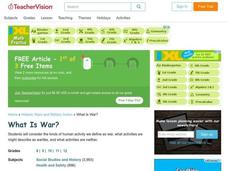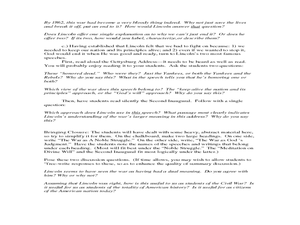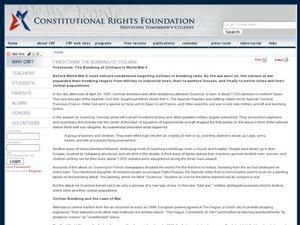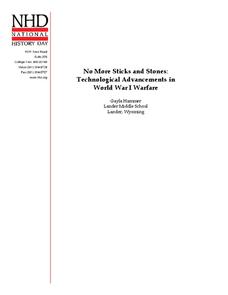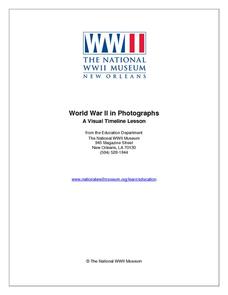City University of New York
Women's Suffrage and World War I
Democracy cannot exist where not everyone has equal rights. Discuss the state of democracy and women's suffrage during World War I with class discussions, debates, and primary source analysis, in order for class members to connect...
Curated OER
What Is War?
What kinds of human activity do we define as "warlike"? Middle and high schoolers examine various definitions of war and types of warfare, especially as these descriptions relate to the kinds of war we are witnessing at the beginning of...
Curated OER
Lincoln and the War’s Larger Meaning
Students analyze Abraham Lincoln's view of the Civil War. In this American Civil War lesson, students read excerpts of Lincoln's speeches to determine whether he had a dual view of the war. Students respond to discussion questions about...
Curated OER
Firestorms: The Bombing of Civilians in World War II
Students examine the implication of civilian targets in war. In this World War II lesson, students investigate the history of bombing practices in war. Students zero in on World War II bombing practices as they discuss precision and area...
Curated OER
Remembering the Forgotten War
Ninth graders examine the major events and significance of the Korean War, including U.S. involvement in the war. In this World History lesson, 9th graders read primary source materials to understand the political, social, emotional...
Curated OER
World War I
Eleventh graders investigate propaganda used during World War I. In this World War I lesson, 10th graders examine propaganda from the war and analyze war posters. Students then create their own propaganda posters on listed topics.
Curated OER
South Koreans in the Vietnam War
Young scholars consider why South Koreans fought in the Vietnam War. In this Vietnam War instructional activity, students engage in an activity through which they investigate why South Koreans fought in the Vietnam War and how...
Curated OER
World War II Quiz 1
In this World War II worksheet, students answer short answer questions about the history and geography of World War II. Students complete 13 questions.
Curated OER
Student Travel in the Shadow of War
Students research on the Web and in magazines and newspapers what a variety of school districts have decided on student travel during the War in Iraq. Students examine the rationale the administrators or state officials use for canceling...
Student Handouts
End to the Cold War
Introduce your class to topics relating to the Cold War through a brief reading selection. Class members read the passage and answer four questions, which are provided on the bottom of the page.
Curated OER
United States Entry into World War I: A Documentary Chronology of World War I
Students identify several important events that led to U.S. involvement in World War I. They examine different explanations, form an opinion about the evidence for each rationale and then create a slideshow to present their findings.
National History Day
No More Sticks and Stones: Technological Advancements in World War I Warfare
Remind young historians that many technological advancements influenced the events of World War I. After analyzing technology's evolution through primary sources, discussing the changes over time, and watching various video clips,...
National Endowment for the Humanities
People and Places in the North and South
North and South: two opposite directions and two opposite economic and social systems in time of the Civil War. Pupils peruse census websites and primary source photographs to understand what life was like for the everyday person before...
Curated OER
The Cold War Era (1945 - 1991)
Provide learners with an excellent resource focused on the Cold War Era. Starting in 1945 and going all the way to 1991, the Cold War Era included major historical events, such as the Berlin Wall, Warsaw Pact, the Korean War, and the...
Heritage Foundation
Congress's War Powers
Declaring war is not as easy as some may think. High schoolers learn about Congress's limits regarding war by reading important clauses in the US Constitution. Various independent and collaborative activities reinforce learning, making...
University of California
Roots of the Cold War
When and how did the Cold War begin? To answer this question, you will not find a better-organized, in-depth, activity- and inquiry-based resource than this! Executing best teaching practices throughout, each portion of this inquiry...
National History Day
Propaganda Posters of World War I: Analyzing the Methods Behind the Images
The power of a picture. During the events surrounding World War I, propaganda posters were widely distributed in American society to sway the emotions of its citizens. By analyzing World War I propaganda posters in the first installment...
Curated OER
First World War Assessment
Here is a really neat assessment, perfect for middle schoolers who have just learned about WWI. The assessment covers the causes and effects of WWI, causes of WWII, the Treaty of Versailles, trench warfare, and key players of the war in...
Curated OER
History: Causes of World War I
Exploring WWI in an interesting discussion of the key events, this resource could be as a great supplement to a classroom unit on this topic. The pictures and information make this period in history come alive. Students would also...
National History Day
“Saving the Bear”: The Russian Expeditionary Force of World War One
How have Russian politics affected countries on a global stage? The discussion of the Russian Revolution and World War I begins with an analysis of primary resource letters. Learners finish with a project where they create a timeline of...
Curated OER
Navajo Code Talkers
An engaging lesson focuses on the contributions of the Navajo people during World War II. Learners read the book Navajo Code Talkers by Andrew Santella, answer a series of comprehension questions about the text, and write a letter...
National History Day
“War Is Hell. We Know it Now.” American Soldiers in the Meuse-Argonne Offensive
Understanding the soldier's experiences during World War I sometimes takes a newscast. Learners see the importance of understanding multiple points of view with a newscast project surrounding the Meuse-Argonne Offensive. Compare and...
National History Day
Uncovering a World at War
Has media always had an influence on public policy? After researching and reading news articles written during World War I, learners understand the influence of communication and media. They discuss articles in small groups and as a...
National WWII Museum
World War II in Photographs
A picture is worth a thousand words, and this activity is worth so much more! Learners closely analyze a series of photographs from World War II, matching them with their appropriate captions and sequencing them into a correct...
Other popular searches
- Star Wars
- Napoleonic Wars
- Punic Wars
- Star Wars Archetypes
- Star Wars Mythology
- American Wars
- Star Wars Vocabulary
- Persian Wars
- Star Wars Lesson Plans
- Star Wars Movie
- Star Wars Music
- Star Wars Media Studies



